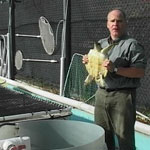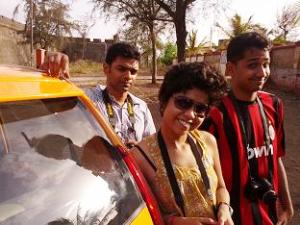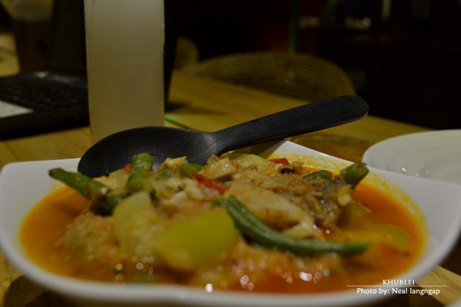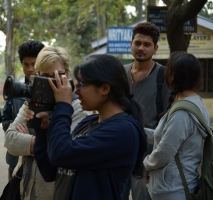Assamese, that’s what I am. That is, I am from Assam, a part of India that has the huge river system of the Brahmaputra running through it, from East to West. This river system also has a vast network of tributaries that feed it. Since Assam is an area of heavy rainfall, it also has numerous ponds and marshy lowlands dotting it.
The point I’m trying to make here is that this is a place where fish abound. The rivers and waterbodies teem with fish, of numerous varieties. Indeed, every district of Assam is famed for a different variety of fish, of the edible kind, of course. It is no wonder, therefore, that the people of Assam are fish eaters. No, wait. That sounds too mild. It would be more correct to say that we are zealous fish eaters, people who pine away if we have to eat two consecutive meals without fish. We are ardent lovers of our fish dishes…and that’s an understatement.
Of course then it goes without saying that there is this huge culture that has grown around fish and the eating of it. Fish is considered auspicious, and is carried along with other things, to marriage ceremonies. The birth of a baby boy is celebrated with the distribution of choice cuts of fish to friends and relatives. And certainly, the way fish is prepared and cooked by a new bride is a marker of her efficiency and expertise. Every home, every housewife, has a special fish recipe that she unleashes on her guests every time she wants to make an impression.
When fish holds a position that is nothing short of iconic in a society, it is a given, then, that the eating of it must be full of conventions and rituals. After all, one cannot treat such an icon with disrespect, especially when the housewife has toiled over it for hours in her steamy kitchen, just so that your tastebuds can exult in its deliciousness. There are, therefore, certain ways in which a fish is served, and eaten.
A baby is introduced to fish very early, within the first year, in fact. The mother starts by feeding her bits from her own portion, a little at a time. She mashes up the fish with her fingers, making sure that no bones remain. She adds a little daal, or some of the curry if it is bland, balls it up with a bit of rice, and feeds it to the infant in her lap. It is always eaten greedily, with much lip smacking by the baby to denote that she appreciates this thing, and would Ma now make it a point to include it in the daily menu, please?
The thing about babies and small children from fish eating cultures like ours is that they learn, very early, how to go about it. No cutlery, of course. Little children, with their tiny fingers handle the pieces on their plates, or banana leaves, with an expertise that is astonishing for those who are from other cultures. Looking at them, you would think they are having something as smooth as mashed banana, or some baby food mush from a tin. They separate the bones from the flesh so easily that it amazes all outsiders who see them. Sometimes, a small bone may make its way into the child’s mouth. But the child is quick to feel it there. He locates it with his tongue, and takes it out from his mouth, putting it at the edge of his plate, or banana leaf, neatly.
The larger fish like rohu and bhokua and catfish are easy to debone. But the saying goes that the tastier the fish, the more small bones it will have. The prized ileesh, or hilsa, is one such. It is lipsmackingly flavoursome, but horrendously difficult to debone. When it is cooked in a mustard sauce and steamed, it is to die for. And yet, it takes a long time to separate the tiny but sharp bones from the flesh. When one has finished eating, there is always a mountain of bones piled up on a side plate. But true fish eaters like the Bengalis and Assamese think that the time spent on it is worth it. For , as the saying goes, “For the love of a rose, the gardener is the servant of a thousand thorns.” Or, in this case, for the love of a fish, the connoisseur is slave to a thousand tiny bones.
The British, always an inventive race of people, tried to get around the difficulties of the bones by inventing the smoked hilsa. No doubt it is delicious, but it is not that famed dish, the chorchori of ileesh in mustard sauce that is nothing short of ambrosia, if cooked well.
The true fish eater will of course always eat with her hands. This means, also, usually, that fish must be eaten sitting down, for who can eat with one’s fingers while standing up? Besides, when one eats with one’s hands, the sense of touch is added to the experience. The feel of the soft flesh of the fish under one’s fingers, the sensation of the fish in its curry, and the mingling of it with the steamed rice is truly magical. In fact may fish lovers insist that they cannot get the true taste of fish unless they eat it with their fingers. Fish eaten with implements, they say, is bland and tasteless.
And in the cultures of the people of Assam, people who eat fish with fork and spoon are looked upon with something like derision. Who is this imposter, they imply, who is this person who has become so Westernized that he has forgotten how to use his fingers in order to eat even something as “native” to our cuisine as fish?
The dilemma arises when one goes out of the region, and is eating out at restaurants, or in other peoples’ homes. All around, people use the cutlery to eat their fish. They cut it up into neat little cubes, and pop it into their mouths, keeping their fingers absolutely unsullied. Everything is proper, everything is alien. The seafood before the diner is crying out to be touched with the diner’s fingers, so that the tactile dimension is also evident. But then, when we are away from our own cultures, it is usually a bit daunting to roll up one’s sleeves, or tuck in the anchal of one’s sari, and plough into the fish with one’s fingers. On the other hand, for those fish eaters who have always eaten with their hands, somehow, the fish doesn’t taste nearly as good if there is cold metal, cutlery, between the fingers and the fish.
There is also the dilemma of taking out the small bones that one finds in one’s mouth. In our homes, it is not considered at all rude to take it out with one’s fingers, and put it on the side plate, or side of the plate. Some people have in fact made an art of it. They take out the little bone delicately, holding it as though it was a flower. Conversation continues around the dinner table even as people are doing all this. But what does one do while using cutlery? You cannot spit it out on the plate, or spoon. That would be gross. And if one is eating at a buffet, how does one balance plate, and fish, and the bone in one’s mouth, to get it out?
Additionally, there is the dilemma of what to do when a bone gets stuck in one’s throat. It does happen, to even the most adept fish eater. While eating with one’s hands, it is the work of a moment to ball up some plain rice and swallow it, without chewing. The rice slides smoothly down, taking the bone along with it. IT’s all very calmly done, and nobody around the table is any the wiser.
But how does one ball up rice when one is using cutlery? It has been tried. But it cannot be done. So the by now coughing and spluttering diner has no option but to use her fingers to ball up the rice. In the meantime, the entire restaurant stares at her, some with compassion, some not.
However, it is heartening to see that a beginning is being made in solving this dilemma. It is becoming increasingly common to see people using their fingers in even the most “propah” places. The relish with which they eat is absolutely delightful. It is also a marker of the confidence of the diners themselves. They are no longer intimidated by the posh surroundings of grand restaurants. They are themselves. They mean to enjoy the meal they have ordered, and since it means they have to eat with their hands to do so, they do it.
This kind of eating with the hands is also a marker of a different kind of thing. The cultural context in which it is placed is now becoming less inconsequential. It is gradually acquiring dominance, in a post colonial world.
And that is truly a fine solution to the dilemmas of fish eaters in a globalized world.







































